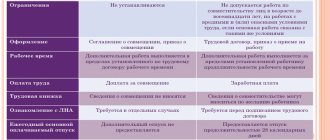The law says that any organization, no matter what size of staff it has, and no matter what type of ownership it belongs to, is required to conduct an assessment of working conditions. Classification of working conditions is a legally established distribution of types of activities according to how much they affect the health of employees. To carry out the distribution, an SOUT is required.
Regulatory and legal aspects that relate to SOUT are set out in detail in No. 426-FZ. To assign one class or another, it is necessary to take measurements and obtain an assessment of the factors by experts. The production environment and organization of the labor process are assessed and the following are taken into account:
- physical, chemical and biological factors;
- the degree of severity and intensity of the labor process, as well as its intensity (static and dynamic loads are taken into account);
- indicators characterizing the environment;
- presence of radiation and fields;
- noise, sound effects, vibration;
- lighting parameters;
- presence of harmful substances in the air.
The indicators must be correlated with the standards established by SanPin, which are available for each factor. The standard indicates safety for human health.
The characteristics of working conditions describe the degree to which the existing conditions differ from the established and acceptable and safe hygienic standards. These are classes of working conditions according to the SOUTH standards, such as optimal, acceptable, harmful, dangerous. The classes of harmfulness, accordingly, are as follows: the first class includes optimal UT, the negative impact is not observed or does not go beyond the limits dictated by the standards. The second includes acceptable conditions, where the degree of adverse impact is such that employees can fully recover before the start of the upcoming work shift, and no additional measures are required for this. The third is harmful conditions, when factors have a noticeable impact on the ability to work of personnel and health status, and the fourth is dangerous conditions in which the negative impact can threaten life or significantly increases the potential risk of developing occupational diseases.
Working conditions according to the degree of harmfulness and danger
The characteristics of the production environment, the effect of climatic conditions, psychological, physical and intellectual stress influence which class the working conditions will belong to. There are four options installed. These are classes of working conditions according to SOUT, such as optimal, permissible, harmful, dangerous.
The classes of harmfulness, accordingly, are as follows: the first class includes optimal UT, the negative impact is not observed or does not go beyond the limits dictated by the standards. The second includes acceptable conditions, where the degree of adverse impact is such that employees can fully recover before the start of the upcoming work shift, and no additional measures are required for this. The third is harmful conditions, when factors have a noticeable impact on the ability to work of personnel and health status, and the fourth is dangerous conditions in which the negative impact can threaten life or significantly increases the potential risk of developing occupational diseases.
Safe working conditions are conditions that can be classified as the first and second classes, that is, optimal and acceptable; harmful ones have an additional classification.
Under safe working conditions, the employer does not have to pay extra for hazardous work or pay additional insurance premiums; in addition, it is permissible to hire people in such jobs without any restrictions on age or health.
If, during the special assessment, the requirements were met, and the working conditions were assessed as optimal or acceptable, then the next special assessment can be carried out ten years later.
Optimal working conditions
If the characteristics of the production environment, the existing loads and their form, in all respects comply with existing standards or are below the parameters established in SanPin, then these are optimal working conditions.
The employee is not exposed to harmful factors, and the stress – both physical and psychological – is optimal. In addition, there are all conditions for food and recreation, there are recreation areas, breaks are provided, etc.
Optimal conditions allow employees to maintain high working capacity for a long time, and at the end of the working day the degree of fatigue is low.
Acceptable working conditions
The second class of working conditions, which also refers to safe ones, are acceptable working conditions. In this case, the number of harmful factors is small and remains within normal limits; they do not lead to serious health consequences.
An indicator of acceptable working conditions is that by the beginning of a new working day, the employee has completely rested and regained his ability to work.
Harmful working conditions
Harmful working conditions are such due to the excess of any standards, due to which the health of workers may be damaged, there is a risk of occupational diseases or the loss of some body functions. Subclasses:
- class of working conditions 3.1: increased workload, the employee does not have time to recover under normal working conditions, there is a risk of harm to health;
- class 3.2: increased exposure to harmful factors, the presence of negative changes in the body of employees, chronic pathologies that do not lead to loss of ability to work;
- class 3.3: employees are constantly exposed to harmful factors, occupational diseases of moderate severity may appear, regular medical examinations, sanitary and preventive treatment are required, which can prevent loss of working capacity to a significant extent or in full;
- class 3.4: increased risk of developing occupational diseases, which often lead to both partial and complete loss of ability to work, and a high risk of disability.
Assignment to classes 3.3 or 3.4 requires a reduction in the working day to 36 hours per week. In addition, the employer must provide additional leave, payments, insurance contributions, etc.
Hazardous working conditions
Hazardous conditions are characterized by the maximum degree of concentration of harmful factors. In some cases there is a threat to life. Employees may come into contact with chemical and biological substances that pose a potential hazard, and they may be exposed to radiation in the workplace. Health risks arise even during one working day/shift.
If the fourth class of working conditions has been assigned, the employer is responsible for replacing equipment or updating it, making changes to the work process that would be aimed at eliminating the high degree of influence of harmful factors.
Working conditions
is a set of factors in the production environment and the labor process that influence the performance and health of the employee.
These factors have a significant impact on the human body, its physiological and mental functions during work, and therefore on working capacity and labor productivity; They are conventionally grouped into the following groups:
1) socio-economic factors, including the legislative and regulatory framework;
2) technical and organizational factors determined by the design, characteristics of the means and objects of labor, the technologies used, protective equipment, as well as organizational forms of production, labor and management;
3) natural factors – geographical, climatic, geological, biological;
4) socio-psychological factors, determined by the nature and characteristics of relationships between people and their groups in work, personal and group values in the world of work, the system of information and communications in the organization.
During the work process, the employee is influenced by harmful and dangerous environmental factors. Their distinction is determined by the peculiarities of their impact on the human body. Harmful factors in working conditions are those whose exposure can lead to the development of an occupational disease (chemical, biological, physical, psychophysiological). Hazardous factors in the working environment are factors the impact of which can lead to injury, a sharp deterioration in health, and even death.
Under certain conditions (for example, with a certain combination or duration of exposure), harmful factors in the working environment (even if they comply with standards) can become dangerous to humans.
Hazardous factors in the working environment include: moving machines and mechanisms or their unprotected moving parts, moving loads, flying parts when processing objects of labor, electric current, elevated temperature, etc.
The following groups of working conditions
:
1) sanitary and hygienic, determining the external environment (noise, lighting, microclimate), as well as sanitary services in production;
2) psychophysiological, determined by the specific content of work activity, the size of the load on the musculoskeletal system, nervous system, and psyche of the worker;
3) labor safety conditions determined by the state of safety regulations and the likelihood of injury;
4) aesthetic conditions, the impact of which determines the emotional mood and attitude to work from the position of artistic perception of reality;
5) socio-psychological conditions characterizing relationships in the work team, leadership style.
The cumulative impact of all elements of working conditions on a person’s working capacity, his health, vital activity, mental abilities, and restoration of the labor force characterizes the severity of labor.
Unfavorable working conditions create an employee’s professional risk. Occupational risk
– this is the probability of damage (loss) to health or death associated with the performance of labor duties stipulated by the employment contract. Occupational risk consists of three components: the risk of damage to health, the risk of occupational diseases and the hidden risk of damage to health.
A person and his performance are influenced by factors that, on the one hand, must be taken into account, and on the other, formed or changed to create the most favorable environment that ensures highly productive work.
Table of contents
FAQ:
How is it determined which class of working conditions a workplace belongs to?
To determine which class of working conditions a workplace belongs to, production factors are taken into account:
- physical – include dust content, temperature, humidity level, noise, vibration, lighting parameters, presence of various types of radiation, air flow speed;
- chemical factors - contact with paintwork materials, acids or alkalis, the presence and amount of harmful substances in the air;
- biological – the presence of pathogens of infectious diseases, spores or microorganisms;
- static and dynamic loads - turns and bends, body position during the performance of work duties, frequency of movements, weight of objects that are lifted or moved by workers during the working day;
- intensity – the need to perform the same type of movements for a long period of time, the presence of mental or emotional stress.
If the indicators are exceeded, employees may experience a loss of energy, lose concentration, and may feel unwell, which, in turn, can lead to injury.
Characteristics of working conditions in an employment contract
The employment contract must specify the characteristics of the production process - activities aimed at transforming raw materials into the final consumer product. The production process can be characterized by:
- raw materials and materials available at the beginning;
- the means by which production is made possible;
- the type of labor involved.
This means that in order for an employee to imagine what he will encounter during his work, it is necessary to characterize the work process as accurately as possible at the stage of drawing up an individual employment contract. For example, if a future employee knows that he will have to work in a metallurgical plant, he can already assess how acceptable the working conditions will be for him. If the conditions are difficult, compensation for difficult work, additional privileges and guarantees can convince people to get a job.
Expert opinion on what to do if a deterioration in working conditions is noticed
It happens that an employee gets a job because he is satisfied with the working conditions specified in the contract. However, after a while he notices changes in working conditions and increased exposure to harmful factors. Experts from the State Labor Inspectorate advise in such cases to report deteriorating working conditions to the employer. If the changes are of a domestic nature, for example, the lighting is faulty, the employer will contact the subordinate responsible for labor protection at the enterprise. The defect will be fixed.
If the employer ignores the words of the employees, it is necessary to contact the trade union organization and demand an unscheduled special assessment of workplaces. If management disagrees, it is possible to file a complaint with Rostrud, the prosecutor's office and the court - if a significant deterioration in working conditions is detected, the employer will be fined.
Why do employers ask about wishes for a place of work?
The question of personal preferences for the workplace is asked for a reason. Just a couple of short phrases in the resume allows you to understand:
- to what extent the candidate’s priorities and beliefs coincide with the company’s values;
- whether the candidate is a competent specialist who knows his worth.
We are all accustomed to employers placing certain requirements on candidates. This is logical, because otherwise a suitable person cannot be found. But you must agree that the opposite situation is just as legitimate - when an applicant is looking for a new position according to certain criteria.
Please note how the applicant for the vacant waiter position described his wishes:
Create resume
After looking at this resume, any employer will immediately understand what a woman expects from a new job. It is unlikely that anyone will offer other conditions (especially if they are worse, not better), knowing that the person will refuse.
Administrative responsibility
In case of violation of the new rules, including the provision banning the use of agency labor, the following measures of administrative liability may occur (Part 1 of Article 5.27 of the Code of Administrative Offenses of the Russian Federation):
- for organizations – a fine from 30,000 to 50,000 rubles;
- for individual entrepreneurs – a fine from 1000 to 5000 rubles;
- for officials - a warning or a fine from 1000 to 5000 rubles.
A repeated violation committed within one year from the date of prosecution for a previous similar violation faces more serious sanctions (Part 4 of Article 5.27 of the Code of Administrative Offenses of the Russian Federation):
- for organizations – a fine from 50,000 to 70,000 rubles;
- for individual entrepreneurs – a fine from 10,000 to 20,000 rubles;
- for officials - a fine of 10,000 to 20,000 rubles or disqualification for a period of one to three years.
Common mistakes
Error: The employer did not indicate in the employment contract the hazard class of work at the enterprise.
Comment: Working conditions, in particular the hazard class, must be specified in the employment contract without fail.
Error: The employee took a hazardous job, after which he decided to go to work part-time at another enterprise with hazardous working conditions.
Comment: You cannot take part-time hazardous work if your main place of work involves performing work duties under the influence of harmful production factors.
Legislative acts on the topic
| Art. 56 Labor Code of the Russian Federation | On the employer’s obligation to provide proper working conditions for employees |
| Art. 57 Labor Code of the Russian Federation | On the mandatory inclusion in the employment agreement of a clause describing working conditions |
| Art. 14 Labor Code of the Russian Federation | On the classification of working conditions |
| Art. 224 Labor Code of the Russian Federation | On payment of compensation for harmful working conditions |
| Art. 147 Labor Code of the Russian Federation | On the minimum amount of compensation for harmful work |
What candidates' expectations inspire recruiters to approve?
The requirements of applicants do not always coincide with the capabilities of employers. However, there are wishes that every leader would be pleased to hear. Please note that the parties perceive the same condition differently.
Wishes for future work in a resume
| Example requirements | Applicant's thoughts | Employer's interpretation |
| Close to home | “I’ll be able to save on travel and spend more time with my family.” | “If necessary, a person will be able to go to work on the weekend or stay longer, because he does not have to waste time on the road.” |
| Stable work | “Salaries are paid on time, friendly staff. The company has a good position in the market. Employees have confidence in the future.” | “This candidate will not run from place to place. It is important for him to perform his job duties efficiently. For our part, we will provide all possible support.” |
| Career | “I’ll show my positive side in this position and then move up the career ladder.” | “The applicant has healthy ambitions and a desire for self-development.” |
You need to be careful with the last point. It is not a fact that the employer will like your professional plans if employees do not stay in a vacant position for a long time.
Special assessment of working conditions
Important! Since January 2014, even office certification is mandatory.
The certification of workplaces, which was carried out by a professional certified commission once every 5 years, has been replaced by a special assessment of working conditions. The employer is obliged to involve specialists to carry it out in order to promptly learn about the deterioration of working conditions, the impact of harmful factors on workers, the presence of areas of production premises hazardous to health and life, etc.
During the assessment, the indicators of biological, chemical and physical factors are measured. Typically, employers carry out special assessments of workplaces every few years, when there is a significant change in the production process or when accidents occur. If it turns out that the workplace does not meet the approved standards, the employer decides how to improve working conditions.
What to write in your resume about your wishes for a new job
Everyone dreams of finding the ideal job. In practice, this does not always work out. Therefore, before writing your resume, set your priorities. Take a blank sheet of paper and a pen. Set your expectations. Start with the most valuable items.
Here are examples of requirements for a new job that a candidate may put forward:
- High salary.
- Availability of a social package, compensation for food or travel and other non-material bonuses.
- Opportunity to undergo professional training at the expense of the organization.
- Official registration, “white” salary.
- Respect in the team.
- Career prospects.
- Social significance of the product (service) of the enterprise.
- Flexible schedule, remote or hybrid work format.
- Proximity of office to home.
- High-quality feedback from management.
- A recognizable brand, a positive reputation of the company in the market.
- Transparency of incentive payments.
- Opportunity to influence the development of the company.
- The presence or absence of business trips and internships.
- Developed corporate culture.
- Innovative work environment, modern office equipment.
- Caring for the health of employees.
- Interesting projects, tasks.
Requirements don't have to be a huge list. It is enough to indicate 3-4 points. Assess the situation soberly: you shouldn’t write everything that comes to mind.
As additional wishes for a new job, you can write in your resume about the amount of salary, the availability of specific software or equipment.
State your preferences if you categorically refuse to work under different conditions.







